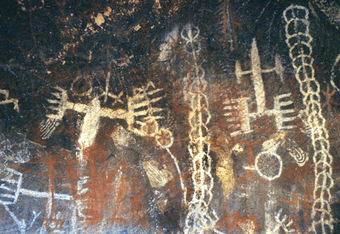Burro Flats Painted Cave facts for kids
|
Burro Flats Site
|
|

Pictographs in the Burro Flats Painted Cave.
|
|
| Lua error in Module:Location_map at line 530: "California" is not a valid name for a location map definition. | |
| Location | Simi Hills, Ventura County, California, United States |
|---|---|
| Nearest city | Bell Canyon, California |
| Architect | Chumash people |
| Architectural style | Pictograph Rock art |
| NRHP reference No. | 76000539 100004883 (decrease) |
Quick facts for kids Significant dates |
|
| Added to NRHP | May 5, 1976 |
| Boundary decrease | July 2, 2020 |
The Burro Flats Painted Cave (BFPC) is a special place in the Simi Hills of eastern Ventura County, California. It's famous for its amazing Chumash-style rock paintings. These paintings are found inside a cave.
The cave and the land around it (about 25 acres) were added to the National Register of Historic Places in 1976. This means it's a very important historical site. The main part of the cave has many colorful paintings, called pictographs. The cave is in the mountains, close to an old village where both Chumash and Fernandeno people lived. Today, the Burro Flats Painted Cave is not open to the public. It's on private land that used to be part of the Santa Susana Field Laboratory.
Contents
Ancient Cave Paintings
The cave paintings at Burro Flats are some of the best-preserved Native American art in Southern California. Experts believe these paintings are several hundred years old.
What the Paintings Show
The pictographs include:
- Two human figures wearing special feathered hats.
- Designs called "raked anthropomorphs" (human-like shapes).
- Figures that might show comets.
- Many other natural shapes and symbols.
A Special Calendar
The people who made these paintings used the site to predict and celebrate the winter solstice. This is the shortest day of the year. It shows how connected they were to the sky and seasons.
Protecting the Art
In 1971, leaders of the Fernandeño tribe asked NASA, who owned the land then, to protect the site. They wanted to keep the paintings safe from damage. They even asked for the cave to be covered with glass. This wasn't done, though, to keep the area as natural as possible. However, the site was fenced off to keep unauthorized people away.
A documentary film called "Cave Paintings of the Chumash Indians" was made about the pictographs in 1978. The land where the cave is located is now being cleaned up. Protecting historical sites like this is a big part of the cleanup process.
Future of the Site
Boeing, another company that owned parts of the land, has agreed to keep their property as open space. This means it will be protected from new buildings or farms. NASA is also planning for its part of the land to become permanent open space after cleanup.
The Chumash tribe has asked for the site to be returned to them. They have also suggested renaming the whole area "The Sky Valley/'Alapay a 'altuqipin Traditional Cultural Property."
To keep the precious paintings safe, the exact location of the cave is a secret. Only archaeologists can visit for research, and members of the local Native American community have regular access.
History of the Area
The Burro Flats area was once part of a large ranch called Rancho Simi. For many years, it was used for grazing cattle and sheep.
Early Explorers and Discoveries
- In 1861, a group led by William H. Brewer explored and mapped California. They visited the area but didn't specifically mention the rock art.
- The first non-Native person known to visit the cave was Walter Brinkop in 1914. He made simple drawings of the art.
- Around the same time, Native American community members told an anthropologist that there was a "very large rancheria" (village) at Burro Flats and "painted caves" nearby.
- In the 1950s, the Archaeological Survey Association of Southern California (ASASC) dug up many artifacts at the site. These items are now kept at the Autry Museum of the American West.
Spreading the Word
The colorful main panel paintings became well-known because of the ASASC's work.
- Artist Charles La Monk made full-size copies of some paintings in 1953.
- Gordon Redtfeldt made sketches.
- Their work helped archaeologists learn about the site.
In the 1960s, Dr. Charles Rozaire studied the area and found several distinct "sites," including the Burro Flats Painted Cave itself (called CA-VEN-160). He noted that the paintings were in the "Chumash-style." This was confirmed by rock art expert Campbell Grant, who visited in the mid-1960s.
Later, in 1973, archaeologist Franklin Fenenga said the site was "one of the major examples of aboriginal American art" and "one of the most important archaeological sites in America." This led to its listing on the National Register of Historic Places in 1976. The 25 acres listed include many places with pictographs (paintings), petroglyphs (carvings), and cupules (small cup-shaped holes).
A Place for the Stars
Starting in 1979, researchers like John Romani and Edwin Krupp (from the Griffith Observatory) discovered something amazing. They found that the site was used to predict and observe both the winter and summer solstices. This discovery made the site even more interesting to people.
More research in the 1990s helped define the site's boundaries more clearly. The main panel of the Burro Flats Painted Cave is now known as CA-VEN-1072, Locus 10.

